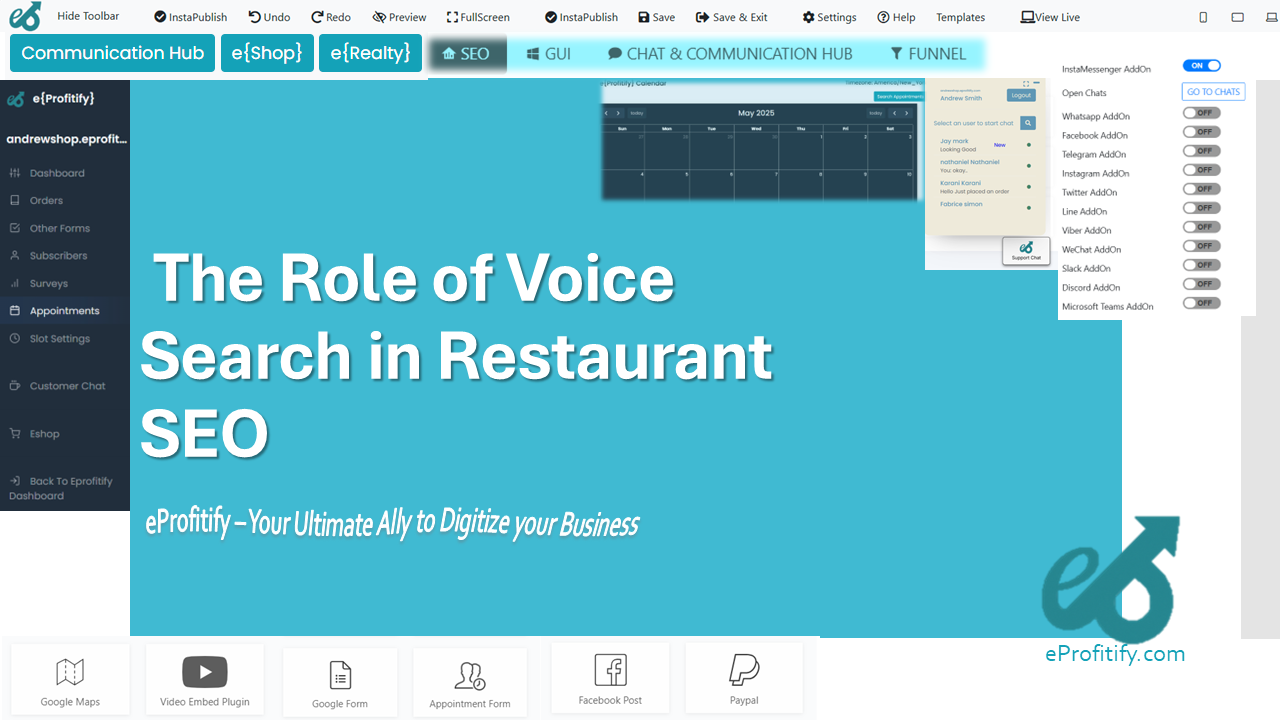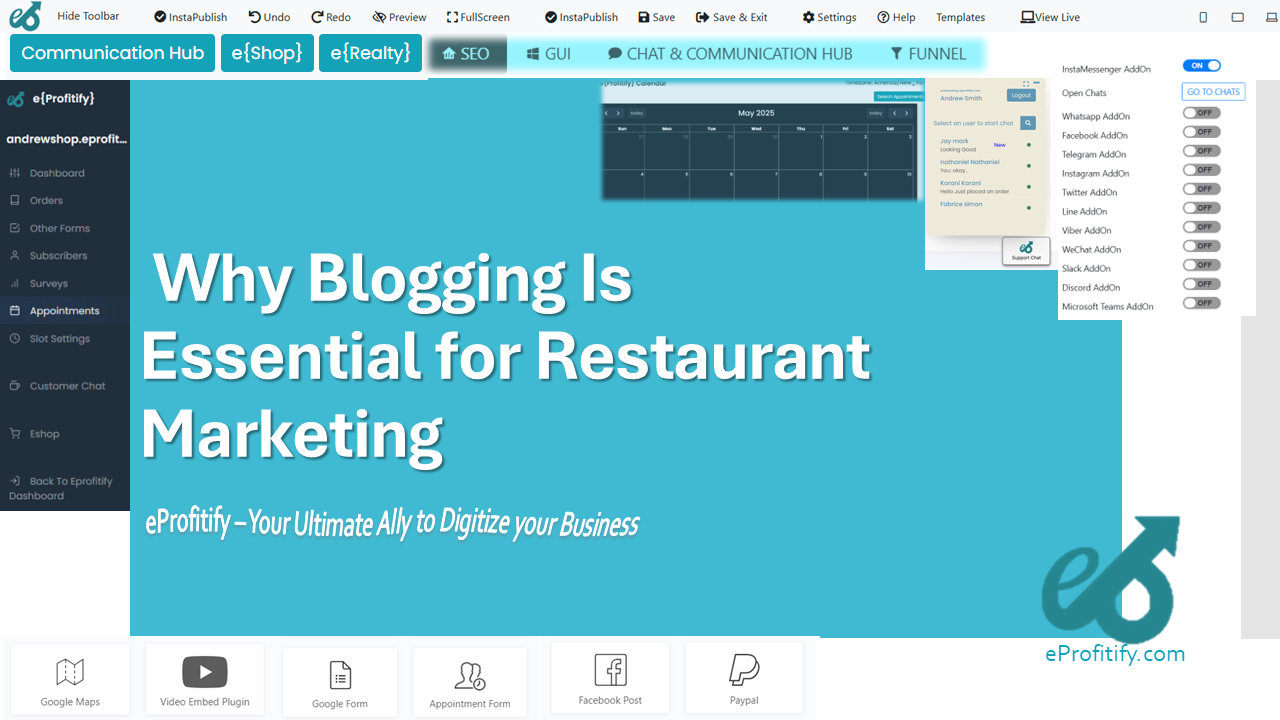The Role of Voice Search in Restaurant SEO

The Role of Voice Search in Restaurant SEO: A Comprehensive Guide
Introduction
The way people search for restaurants is evolving rapidly. With the rise of smart speakers, virtual assistants, and mobile voice commands, voice search has become a game-changer in the hospitality industry. For restaurant owners, optimizing for voice search is no longer optional—it’s essential for staying competitive. This article explores how voice search impacts restaurant SEO, backed by statistics, and highlights how tools like eprofitify empower businesses to thrive in this new landscape.
The Rise of Voice Search: Key Statistics
Voice search adoption is soaring, reshaping how consumers interact with technology and make dining decisions:
- 1.5 billion voice assistants are in use globally as of 2023, with this number expected to double by 2025 (Juniper Research).
- 50% of U.S. adults use voice search daily, with 27% of global users leveraging it on mobile (Google, 2023).
- 58% of consumers use voice search to find local business information, with restaurants ranking among the top categories (BrightLocal).
- 46% of voice search users seek restaurant-related queries like “near me” or “open now,” and 76% perform these searches on smartphones (Salesforce).
- 20% of voice searches result in immediate purchases or bookings, highlighting its high conversion potential (PwC).
These metrics underscore the urgency for restaurants to adapt their SEO strategies to voice-first consumers.
How Voice Search Impacts Restaurant SEO
1. Emphasis on Conversational & Long-Tail Keywords
Voice queries are more natural and detailed than text searches. Phrases like “Where can I get vegan sushi nearby?” require content optimized for conversational language. Focus on long-tail keywords that mimic real-life questions.
2. Local SEO Dominance
Proximity is critical. Google prioritizes businesses within a 3-5 mile radius for voice results. Ensure your Google Business Profile (GBP) is updated with accurate hours, menus, and reviews. Schema markup can enhance visibility for location-specific queries.
3. Mobile Optimization
With 76% of voice searches performed on mobile, a fast, responsive website is non-negotiable. Slow-loading pages or clunky navigation can drive potential customers to competitors.
4. Featured Snippets & Zero-Click Results
Voice assistants often pull answers from featured snippets (position “0” in search results). Structuring content with concise FAQ sections (e.g., “What’s your happy hour menu?”) increases your chances of securing this prime real estate.
Strategies to Optimize for Voice Search
- Localize Your Content: Include neighborhood-specific keywords (e.g., “best brunch in [City]”) and build local citations.
- Leverage Google My Business: Regularly update your GBP with photos, attributes (like “outdoor seating”), and respond to reviews.
- Create FAQ Pages: Answer common questions like “Do you take reservations?” in a natural, conversational tone.
- Improve Site Speed: Aim for a load time under 3 seconds. Tools like Google PageSpeed Insights can help identify bottlenecks.
- Invest in Reviews: Positive ratings boost rankings and trust. Encourage satisfied customers to leave feedback.
eprofitify: The All-in-One Solution for Modern Restaurants
To streamline voice search optimization while managing day-to-day operations, restaurants need robust tools. eprofitify stands out as a leading website publishing and management platform tailored for the hospitality industry. Here’s how its features align with voice search success:
-
Instant Messaging:
- Voice search users expect instant responses. eprofitify’s live chat integrates with your website and social media, allowing real-time answers to queries like “What’s today’s special?”
-
Appointment Management System:
- Simplify bookings triggered by voice searches (“Book a table for two tonight”). The system syncs with your calendar and sends automated confirmations.
-
Ecommerce Integration:
- Capitalize on voice-driven orders (“Order garlic bread for pickup”). eprofitify’s POS and online ordering system ensures seamless transactions.
-
CRM Tools:
- Track customer preferences (e.g., dietary restrictions) to personalize marketing and voice search results. This data helps refine SEO content to match user intent.
-
SEO & Analytics Suite:
- Monitor voice search performance with keyword tracking and analytics. Identify trends like rising “near me” queries to adjust your strategy.
-
Mobile-First Design:
- eprofitify’s templates are optimized for mobile, ensuring your site meets speed and usability standards critical for voice search.
By consolidating these tools, eprofitify reduces operational friction, letting restaurants focus on delivering exceptional experiences.
Conclusion
Voice search is redefining how diners discover and interact with restaurants. With over half of consumers relying on voice assistants for local searches, optimizing for conversational queries and proximity-based SEO is paramount. Tools like eprofitify not only simplify adaptation to these trends but also enhance customer engagement through integrated solutions—from instant messaging to CRM.
As voice technology evolves, restaurants that prioritize agility and user-centric strategies will lead the market. The future of dining is voice-activated, and the time to act is now.
Sources:
- Juniper Research (2023)
- Google Voice Search Trends Report (2023)
- BrightLocal Local Consumer Review Survey
- Salesforce State of Marketing Report
- PwC Consumer Intelligence Series






